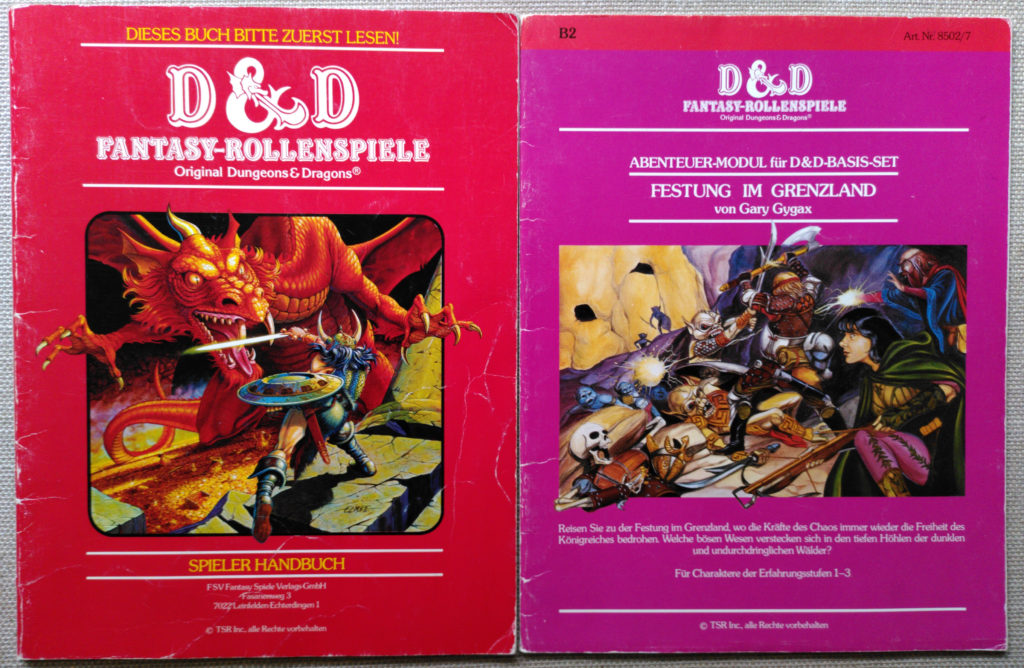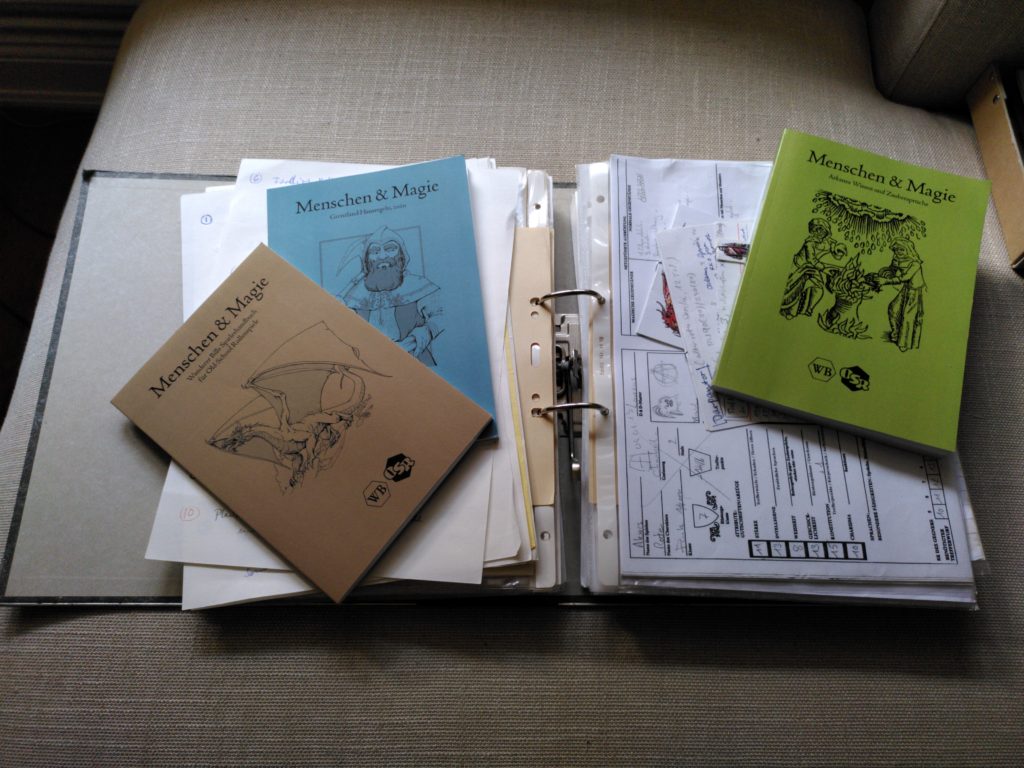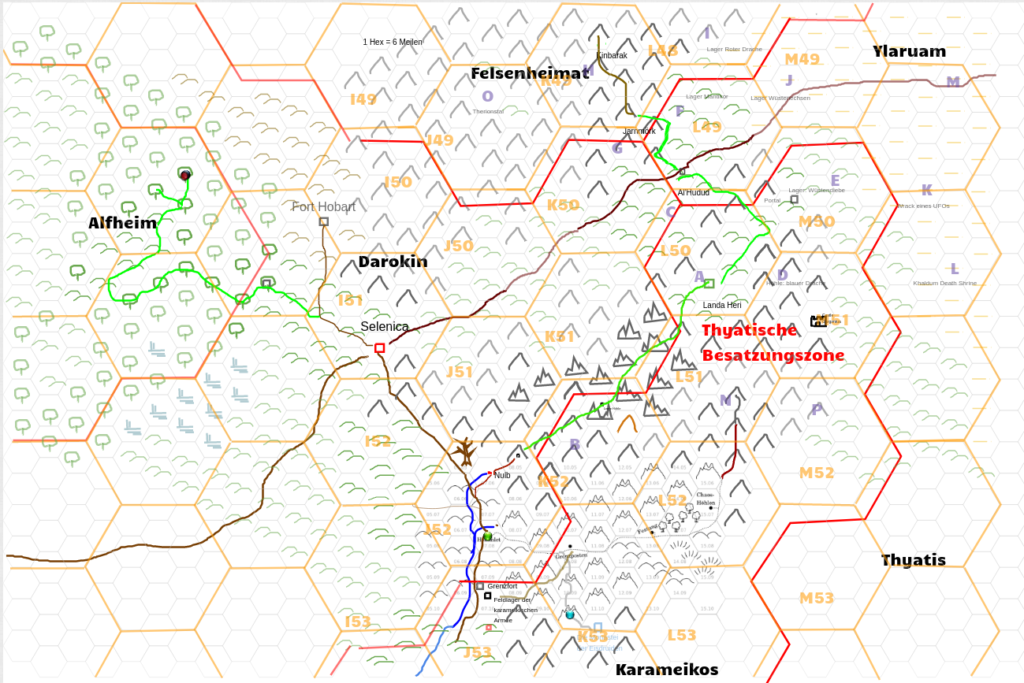Back in March 2022 while having refereed some 15 sessions of our Traveller 5 Octagon Campaign, I stumbled across some posts about Patron Style play in classic D&D campaigns. Patron style play is often, and probably much more commonly, referred to as domain level play, or simply domain game, so think of those terms as being synonyms for each other. I’ve commented on the topic in general over here. In any case, I was so fascinated by the idea, that I tried to incorporate domain level play into the ongoing campaign.
While I’m still convinced, that patron style play is a great idea, which should be conducive to the campaign style I’m aiming for, I must admit that my experiment didn’t work out as expected. I’ll try to pin down a couple of reasons as to why this happened, and what I’d likely try, in order to be more successful in the future.
This is a lengthy post. For a quick read, you might want to skip ahead to the section “So, what happened?” below. For the dauntless, let me begin by briefly recapitulating:
Domain level play? Patron style? What are you talking about?
Just to give you a quick idea, in patron or domain level games, players take up the roles of influential rulers and leaders who might command armies and may have large amounts of resources at their disposal. With this kind of gaming, players are more or less expected to play antagonistically to each other, rather than play the usual collaborating adventuring party. Of course domain level play harkens back to the war games, our modern role playing games developed out of.
The fascinating thing about domain level play as part of role playing game campaigns is the potential for the players to generate their own adventure hooks. If for example a player fancies, the prince she’s playing is going to invade the neighboring country: Conflict arises and adventure hooks follow naturally: someone has to scout out the enemies defenses, bands of raiders might be hired to steal money and weapons to fund the invasion, and so on. Sometimes things might be played out in the manner of your usual role playing, other times large scale conflict might be solved using actual war gaming rules.
Patron Characters in the Octagon Campaign
The Octagon Campaign had four Patron Characters. There was pharma business tycoon Virginia Edgerton, played by @kensanata:
# Virgina Edgerton
UPP 773A9C (50) Citizen, 7 terms, home world: Vland (A967A9A-F Hi Cs)
Broker-13, Admin-3, Trader-3, Advocate-3, Bureaucrat-3, Psychohistory-3, <One Science>-3, <One Art>-1, Computer-1, Counsellor-1, Liaison-1, Hostile Env-1, Rider-1, Streetwise-1
## Commonly known information
Ruthless entrepreneur with main base in the Rhylanor Subsector. Fame-20 (sector wide). Her portfolio includes, among others, Fico Pharmaceuticals & Insurances. The tabloids say she owns a superyacht on Rhylanor.
## Goals/Motivation
* Increase your wealth
* finally be ennobled
* Expand Fico Pharmaceuticals & Insurances
into a sector-wide MegaCorp.
## Resources
* 400 foot super yacht on Rhylanor with
landing platform for her speeders. Skipper
*Elon Linkovich* is loyal to Virginia.
* Generally good relations to the high
society of Rhylanor, including the Duke.
* 100% ownership of Fico Pharmaceuticals &
Insurances, annual sales MCr 950
* Stocks/Shares:
- Rhylanor Shipyards (overhaul, repair,
construction of star ships): 10%
- Oberlindes (Major shipping line, feeder
routes to all major starports, charter
traffic outside imperium): 0.1%
- Tukera (Long Distance Shipping along
XBoat Routes) 1%
There was the mighty Duke of Rhylanor, played by Conti:
# His Grace Cosmin Hault Draghicescu, the Duke of Rhylanor
UPP 4658AF (62) Noble, 11 terms
World Knowledge (Rhylanor)-8, Advocate-5, Leader-4, Navigation-4, Flyer-3, Bureaucrat-2, Blades-2, High G-2, Strategy-2, Comms-2, Artist-2, Athlete-2, Diplomat-1, Language (Zhodani)-1, Liaison-1, Tactics-1, Philosophy-1, Zero-G-1
## Commonly known information
The Duke owns a princely estate on Rhylanor, as well as lands on various planets in the Rhylanor sub-sector. Formally representing the interests of the Emperor, Strephon Aella Alkhalikoi. He is the commander-in-chief of the Rhylanor Imperial Navy.
## Goals/Motivation
* Maintain law and order in the sub-sector
* Prevent another Zhodani invasion, at least
stand out as a victorious general.
* Secure and increase family wealth
* Advance to Sector Duke of the Spinward
Marches
## Resources
* Royal estate on Rhylanor
* Land grants on Rhylanor and all other
main worlds in the subsector with a base
income of around 3.8 MCr per year.
* 25 proxies in the Imperial Parliament,
the *Moot Spire* on *Capital*, messages
take about a year there and back.
* Commander-in-chief of the Rhylanor
Subsector Navy.
The following can be mobilized at short
notice:
- *Ruthless*, Batte Cruiser, Regal class,
75,000 tons, Jump-4, currently in the
Regina system (Regina subsector)
- *Revenge*, Regal Class Battle Cruiser,
75,000 tons, Jump-4, currently in the
Rhylanor system
- *Regulator*, Regal Class Battle Cruiser,
75,000 tons, Jump-4, currently in the
Lonesda system
- Two 400 t *System Defense Boats* Jump-0
in each system of the subsector
- Squadronds of three 400 ton *Type CE
Close Escorts*, Jump-4 in the Rhylanor,
Jae Tellona, Margesi and Porozlo systems
There was the smart Zhodani Agend Karthik Salvi, played by Moritz:
# Karthik Salvi
UPP 674B59 (44) Agent, 6 terms
Bureaucrat-3, Grav Flyer-3, Stealth-2, Language (Anglic)-2
Navigation-2, Pilot-2, Turrets-2, Vacc Suit-1, Survival-1, Rider-1,
Streetwise-1
Codename: the jackal
Chief agent of Zhodani Intelligence in the sector. A slim,
tall man with a carefully trimmed full beard and accurate manbun.
## Goals/Motivation
* Undermine and weaken Imperial forces
in the Rhylanor sub-sector.
* Gather intelligence to prepare for
another invasion of the sector.
## resources
* Intelligence base on Fulacin disguised
as a company MagnetoDynamics Inc., which
operates the class A spaceport.
* Agents on Yori/Regina subsector, Jae
Tellona and Gitosy, both Rhylanor
subsector.
* encrypted communication to the
following Zhodani ships:
- "Aasha" - Shivva Class Patrol Frigate
600 tons, Jump-4, currently on diplomatic
mission in Celepina system (Rhylanor)
- "Aazaadee" - Shivva Class Patrol Frigate,
600 tons, Jump-4, currently on a secret
mission in the Gitosy system
- "Pragati" - Shivva Class Patrol Frigate,
600 tons, Jump-4, currently on a secret
mission in the Henoz system
At first none of the other players knew that Moritz was secretly playing an enemy spy. I saw much potential in this set up, but I will comment on this later.
Finally there was the head of an extra-imperial corporate state , one 07#23MAJ, called “Major Seven”, played by Pyromancer:
# Director 07#23MAJ
called *Major 7*, Home world *Termous Dex* (Vilis)
UPP B4A8AB (54), Genetic Profile: 6644XX
Merchant 4 terms, Functionary 6 terms.
Bureaucrat-9, <one art>-6, Broker-5, Leader-5, Admin-4, Advocate-4,
Biology-3, Steward-3, Strategy-3, Vacc Suit-2, Diplomat-2, Driver-0
(Grav-2), Comms-2, Astrogator-1, JOT-1, Sensors-1, Teacher-1 Trader-1
Benefits: Directorship, Life insurance, Knighthood (Soc B)
## Commonly known information
Major 07#32MAJ, known as Major Seven, is the chief official of the
Tremous Dex Inc.
Obvious resource is the planet located outside of the Empire:
Tremous Dex in the Vilis subsector. As the supreme decision-making authority, Major Seven has ultimate authority over the merchant fleet
of Tremous Dex, all ships of the 2,000 ton CARAVAN class. How many
there are, where they are currently located, and ultimately, the where abouts of Major 7 are not known.
## Goals
* Open up the market for high-tech
pharmaceuticals in the Spinward Marches.
* If necessary, drive potential competitors
out of the market.
* Develop the market for industrially
manufactured "Synthetics", i.e. androids
based on human clones
* Research project: programmable psionics.
There is a constant need for psionic
gifted "breeding material".
* Ultimately introduce psionically
controllable military androids, with the
Zhodani Consulate being the most likely
buyers.
## Resources
* The planet Tremous Dex (Vilis subsector),
with a factory that produces human clones
and synthetics with high efficiency.
* 10 ships of the 2,000 ton CARAVAN class
- 3 of them, numbers X76, X21 and X98
are currently located on a trading trip
in the Zhodani Consulate
- 3 CARAVAN ships X28, X33 and X95 are
in the home system Tremous Dex.
- 4 ships are currently in the Spinward
Marches:
The X42 under Commander Zes 62#13ZES,
currently in jump space between *Jae
Tellona* and Rhylanor. The ship will
arrive 064-1106.
The X12 under Commander Major
07#23MAJ (that's you!) in the Porozlo
system (Rhylanor). A civil war is
currently looming there.
The X13 under Commander Roc 87#18ROC
in the Paya system (Aramis)
The X99 under Commander Hui 44#99HUI
in the Extolay system (Lanth)
The Patron Game Turn
I send out “News” to each Patron player once per week, asking for a reaction. Here’s an example of the news I initially send to the Duke:
## News 014-1106
* The *CARAVAN X42* a large trader ship
owned by Tremous Dex Inc. is currently in
the Henoz system. It is assumed that the
journey will continue via Celepina to
Jae Tellona.
* A price war appears to be brewing between
the Shovelton and Oberlindes trader lines.
* Smugglers are regularly caught in the Jae
Tellona system.
* Fico Pharmaceuticals & Insurances, a
company wholly owned by oligarch Virginia
Edgerton (also based on Rhylanor), seems
concerned about competition from Tremous
Dex. Rumor has it that Virginia is preparing
to send a trade delegation to Tremous Dex.
I gave the following basic instructions to each patron player:
As a reaction, a written order is then sent back to the referee, who will implement the effects in the campaign world. Anything could be ordered: sending out diplomatic missions or agents, assembling troops, throwing a party for the rich and famous, whatever. And even if someone were to declare war, the campaign can’t be ruined by it. It would only get more dramatic. There can/may/should be interaction with the regular player groups. For example, the assignment of a special unit to steal industrial secrets could lead to an adventure for one of the player groups.
These were basically “the rules”. Reactions varied quite a bit from concise, bullet pointed orders, to lengthy explanations of general strategies, to play by post style, first person statements and descriptions of imagined dialogues.
So, what happend?
First let me say, that all players send back great orders and reactions. Some were puzzling, almost all entertaining, and I saw dedicated engagement in the characters and the gaming world, all around.
The domain game provided some color. It was fun to have the players scan a system, reveal a Zhodani Ship far out, and know, that this particular ship is actually controlled by a player.
As expected some interesting plot hooks were generated, the highlights of which were:
- Assemble pirate crews to interfere with Tremous Dex Inc. and destabilize the neighboring subsectors with a ducal letter of marque.
- Recruit a covert mission to Gerome to get a sample of the clones alledgedly produced there.
- Assassinate the Dukes Spy.
Unfortunately, neither of these became relevant. In one instance I could have introduced the Covert Mission to Gerome but, simply forgot about it. In all other instances, the characters were simply to busy with whatever they were doing, and had no demand for new jobs or missions.
My favourite situation that arose from the domain game, was the opportunity to let one of the patron characters, Karthik Salvi, the Zhodani Spy, have a “cameo appearance” during one of the regular sessions. The players were quite surprised when their characters went to see the star port warden and suddenly a new player joined our sesssion to act as an antagonistic player. The effect for me as the referee was actually amazing: I could lean back and watch the situation unfold as the opposing characters played out the situation.
Apart from that, all patron players obviously had to struggle with the “slow” speed of communication. As in the Traveller Universe news won’t travel faster than jump speed, most of the time the players saw the results of their orders literal weeks later. For example, when Karthik‘s Agent Cobra had been uncovered by Major Seven, it took two actual weeks to get the information back to Karthik, almost a month after Karthik had ordered Agent Cobra to go on her secret mission in the first place. For me as a referee this generated a feeling for how enormous those astronomic distances really are, but I think it was quite difficult for the players to maintain a feeling of ongoing plot that way. Really, a lot of information generated in the domain game simply got lost. Almost none of the players realized, that one of them was actually playing an enemy spy. A timely reveal might have led to a very different, and much more interesting development of events.
Curiously two of the Patron Characters, Virginia Edgerton and Duke Draghicescu were in the same system all the time. By logic of the basic Traveller rules, their players could have comunicated with each other directly, with no imposed delay at all, even without knowledge of the referee, but they consistently relied on me relaying the communication back and forth. I assume they simply didn’t realize the advantage they actually had.
Also, I quickly felt, that whatever the Patron Characters did seemed to be lacking in terms of consequences. There were almost no game mechanics to engange with, hardly any risks to be felt, no obvious gains to be won, appart from interactively telling the story. And the story as a whole was only visible to me as the referee, anyhow. There was just too little feedback of the Domain Game back to the regular players.
Finally, the most crucial problem I found was this: Each week I prepared a seperate set of news items for each player and relayed all messages back and forth between all players. As the players orders were in no particular, or standardized format, this afforded a lot of rephrasing, paraphrasing, formatting, and paying attention to the speed of news, as well as keeping a calender to remind myself, when some remote event would actually become known to each player respectively. Plainly, this was just too much work! Before the end of the campaigns first season I gave up on the domain game, to be able to concentrate on the two regular gaming groups.
While at the time all of this felt like a failure then, I can now see:
My takeaways
- Generously feed back any developments in the domain game to the whole group. Make sure everyone knows what’s going on. Start sessions with current XBoat News, gossiping tavern patrons, summaries of current rumors, whatever is appropropriate to the setting. Make everyone benefit from the extra work. There will still be enough fog of war.
- No free form orders. Everything must be send as a message with a clearly stated recipient, ready to be relayed as is. NPC recipients will adhere to the word as precisely as possible.
- Encourage direct communication, whenever the situation allows it.
- No individual news posts. “Publish” campaign news for everyone to see, other than that, only relay messages as stated above.
- Use the rules and mechanics the respective game system provides: Traveller has the Social Status attribute, military ranks and a hierarchy of nobility, D&D has rules for “name level” characters and their strongholds. These are the basics for any domain game, they’re baked into the original rules, and they are there for a reason.
- Use the monetary systems, the rules provide. They make risks and gains tangible.
- Be explicit about the speed of communication.
- After all, it still was fun, I enjoyed what we did! I hope the players did, too!
Interestingly Classic Travellers Adventure 05 Trillion Credit Squadron provides a valuable template for a domain game in a science fiction setting, and is quite explicit about precisely these issues. I wish I had read and digested what was put forth about Patron Style Games back in 1981, before introducing patron characters into our campaign!
So, did this Domain Game fail? I’m not so sure anymore. I feel it did fall short of what we hoped to get from it. Then again, it’s still been a valuable experience for me, and I think I learned a few things about how to better set up the next Grand Campaign.





